
Dear Blog Readers— I am back on Lampedusa – that little slip of an Island that is a closer to Africa than to Italy – the destination for tens of thousands of migrants every year. (See Blog Post: Lampedusa: Europe’s Port).
This time I am back for a story on the beginning of Operation Triton, a joint European effort to patrol the Mediterranean waters around Italy and save migrant ships in distress at sea. This operation is taking over from Mare Nostrum, the Italian operation which was launched in October 2013, shortly after a migrant ship sunk off the coast of Lampedusa leaving over 300 people dead. (see Blog post: Into the Deep Blue Cemetery off Lampedusa).
Mare Nostrum was a massive effort by the Italian Navy to rescue all boats coming from North Africa. It cost Italy 9.5 million euros a month and involved five navy ships and five planes. Over the course of a year (from October 2013 to October 2014) they made 558 rescues and saved 100,250 people. During that period 499 migrants died at sea, 1,446 disappeared and they have been unable to identify 192 cadavers. They also arrested 728 traffickers.
Over the past year, Italy has pushed hard to get Europe to step up and take over the operation of patrolling the coast. Europe moved slowly, as usual, and Italy quickly developed a policy of letting the migrants move through Italy without being finger-printed so they could claim refugee status in other countries.
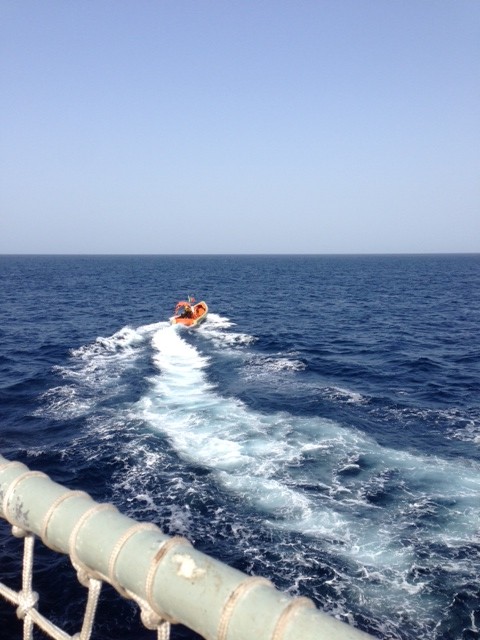
To see Operation Triton in action, the group of journalists from Italy, France, Germany, Britain and the US gathered in the port early and were taken in groups of four on a Dutch patrol boat out to the Portuguese open sea patrol vessel.
As we flew across the rough sea sometimes the nose of the boat seemed like it was going straight up in the air and just as I thought we would flip over backwards, we came crashing back down in the trough before riding up on the next wave. It was slightly unnerving but I figured the Dutch sailors knew what they were doing. Emma, a British correspondent for The Guardian, told me she had taken some heavy-duty seasickness pill and I was wondering if I should have too as we charged along flying over the tops of the waves and then came plummeting back down.
When we pulled up alongside the Portuguese ship, the Viana Do Castelo, they lowered a rope ladder, which looked easy enough to climb, but with both boats bouncing up and down on the sea it was a challenge. We all grasped and struggled our way up as the sailors on top reached down to pull us in. Over the course of the day, we had a fascinating look at how their operations work.
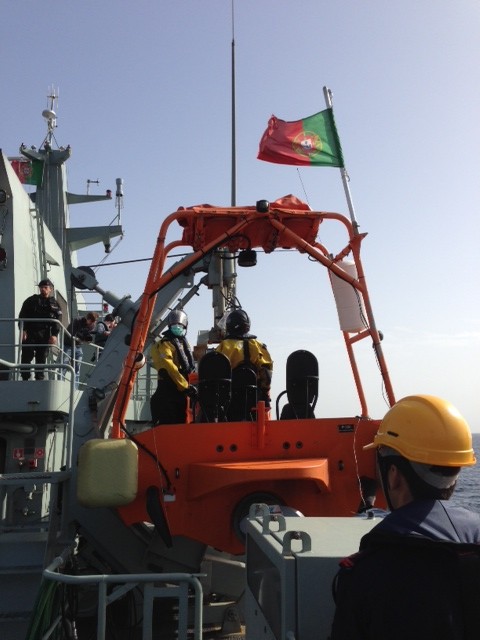
Unlike the Italian “Mare Nostrum”, Operation Triton is patrolling a much smaller area – only the 30 nautical miles off the south of Italy’s coast. Nineteen EU countries are now contributing to the operation and the total cost is 2.9 million euro per month, only a one-third of the cost of the Italian operation.
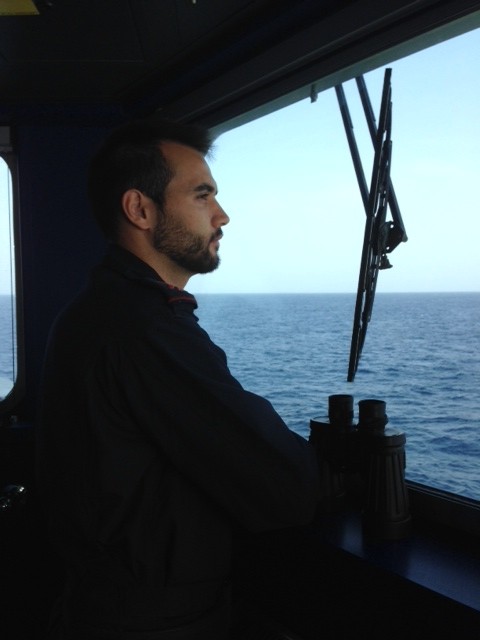
We interviewed Veronica Sousa, a nurse aboard the ship who told us they were prepared for many eventualities including delivering babies (many migrant women arrive pregnant and some have delivered babies aboard rescue vessels), helping children, dealing with severely dehydrated passengers. She also explained that they have “sanitary kits” for dealing with migrants that might have infectious diseases such as Ebola. The Triton operation has three large ships and two patrol boats, 2 planes and one helicopter involved in surveillance operations. As we stood on the deck of the Viana Do Castelo, a Finnish surveillance plane roared past overhead heading out to sea to try to spot migrant ships.
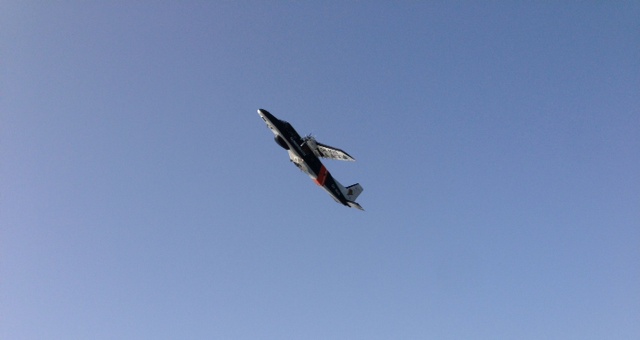
Back at the airport in Lampedusa, I had a chance to speak to the Finnish pilot Captain Lauri Pakkala of the Finnish Border Guard who explained, they must fly high above the water, never letting the migrants ships see them. If the migrants on board a ship realize they have been spotted by rescuers, they “might resort to activities that might be dangerous to themselves such as throwing away life jackets or things like that. They might assume that as soon as they are spotted that they will be rescued quite quickly which might not always be the case.”
During my time on the ship and on shore, I had a chance to talk at length with Izabella Cooper, the spokeswoman for Frontex, the European Agency which oversees joint border control operations. She has been following the migrant crossings of the Mediterranean for years. Frontex has teams of de-briefers who speak to the migrants and ask them to volunteer information about the traffickers. According to Frontex, which has been collecting data for the past seven years, 2014 has had the most migrants with 140,000 arriving on the coasts of Italy from Libya.
Izabella told me ““Libya is a de facto failed state without functioning law enforcement authorities, which creates a bonanza for the smuggling networks to operate. The smugglers run what we can easily define as a zero-risk, high-profit activity. They can make up to one million Euros on a boat with up to 450 people on board.”
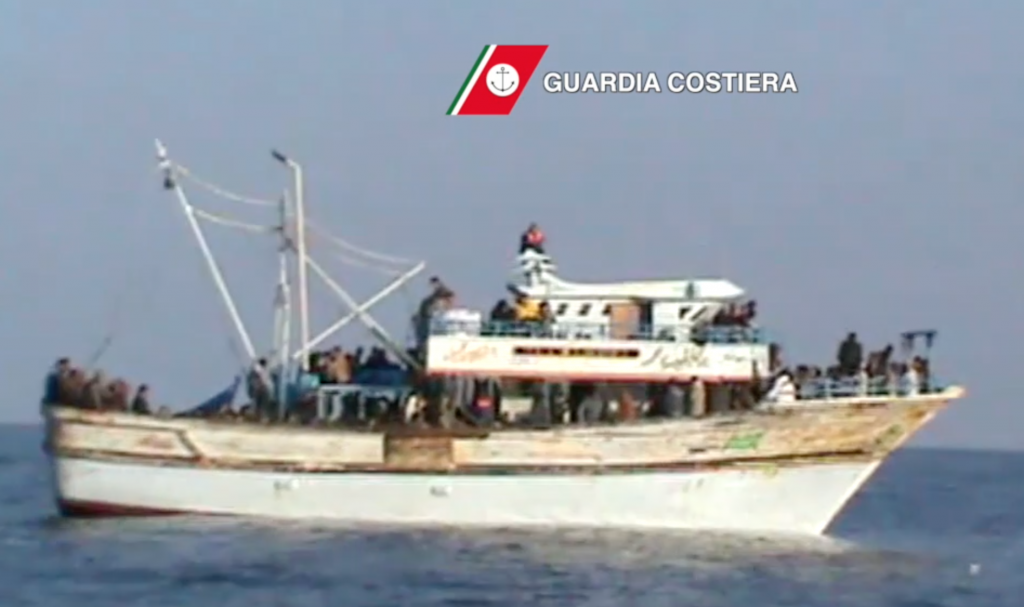
She explained that they have noted a significant increase in brutality and violence on the part of the traffickers. Apparently some of the migrants arrive at the shore in Libya, see the boat they are supposed to travel on and realize the risk. If they try to turn back, the traffickers violently force them on board.
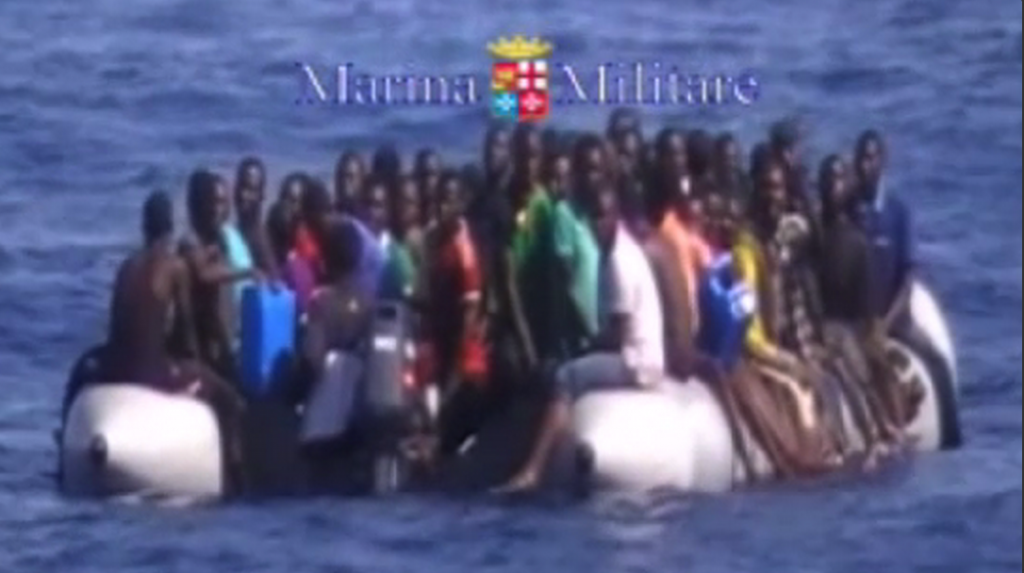
According to Izabella, “if the smugglers see any indication or lack of subordination they react with violence….We are finding there are incidences of stabbings on board and migrants being thrown overboard. They are now even using electric tasers to shock people to keep them calm if they think they are getting agitated.”
Izabella also explained they have discovered a heavy dose of racism in the trafficker’s behavior, “We have indications that black Africans are put below deck and locked in the hold so they can’t get out. For several days they are forced to breathe the engine fumes. If there is an accident, there is no way for them to escape.”
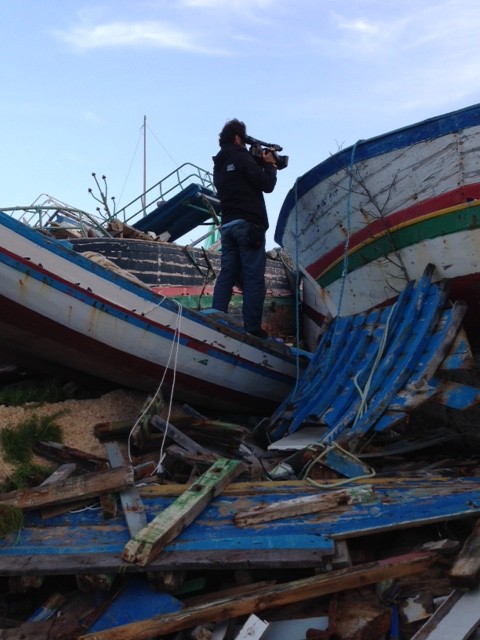
Back on Lampedusa, my AP Television VJ colleague Paolo Santalucia and I rented an ATV (a four-wheel all terrain vehicle), to buzz around the island talking to the people about how they saw the situation. We filmed the boat graveyard at the edge of the port where over the years the rotting migrant boats have piled up. We went to the Isola dei Conigli (Rabbit Island) –see panoramic photo above_- to see the place where the 366 migrants died last year. We visited the Holding center on the island, which is now being refurbished, but a year ago was packed with hundreds of migrants. I was fascinated by the writing on the walls in the women’s dormitory – their names, a dove, a cross, and several women had written “I love you” and the name of a man.
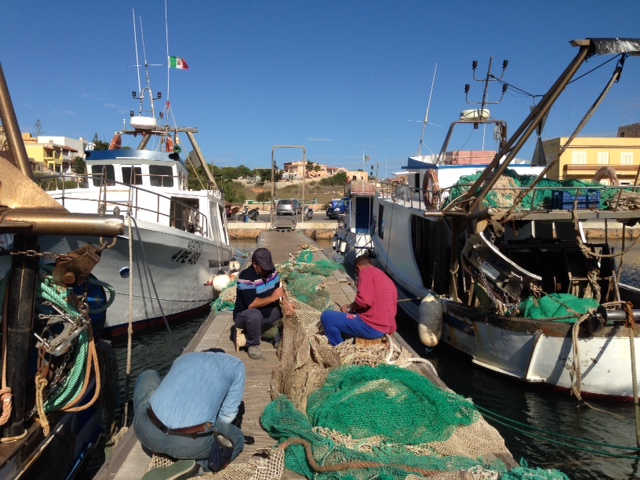
In the port, we found a couple of fisherman repairing their nets because the sea was too rough to go out. We chatted with them for a while to get their thoughts on the migrant situation – and I couldn’t help thinking how much they reminded me of fishermen I have seen repairing nets in Gloucester, Massachusetts, or Portland, Maine.
Pasquale Palmisano looked up from his work, put a hand on his heart and said in gruff tone, “Mare Nostrum or whatever other name you want to call it, does not change anything at all for us. They must go look for them (migrants) over there, on the other side, on the other shore, it is useless that they leave them in the middle of the sea, the accidents will always happen.”
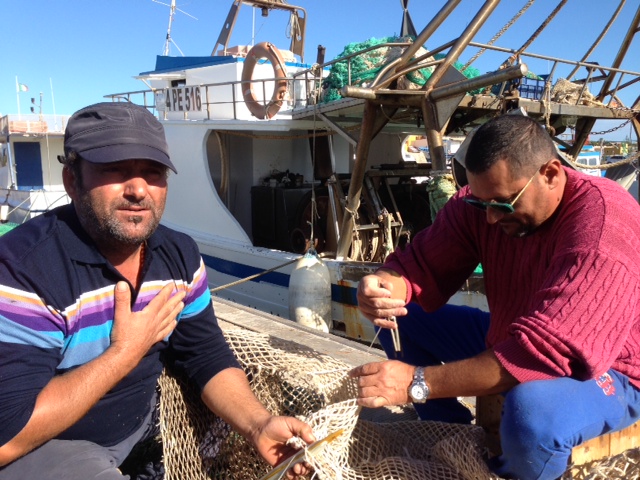
The fisherman of Lampedusa know a thing or two about rescuing migrants, over the years they have rescued many themselves, pulling drowning migrants onto their boats and carrying them to shore. It was a fisherman who first found the migrants off Rabbit Island.
After that sinking, I interviewed Tadese Fisaha, a 29-year-old survivor from Eritrea. With tears in his eyes, he told me that when the ship sank, although he did not know how to swim, he managed to tread water for three hours as his family members and friends died around him. Finally a fisherman arrived and pulled him out of the water.
For the moment, there are many less migrants arriving. The weather has been bad and the sea is rough, but on Lampedusa the residents wonder what will happen come spring when the weather is warm and the sea is calm.
There is something about Lampedusa that seems like a frontier town, an outpost. The main street – Via Roma – is a wide deserted avenue with a line of shops and bars that reminds me of a far west ghost town.
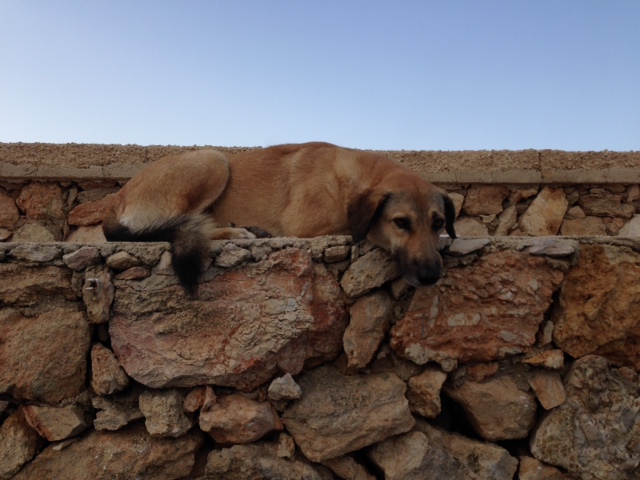
Stray dogs wander about like they own the place. Lampedusa residents buzz around on mopeds without bothering with helmets. For the moment everything is tranquil but I have a feeling I will be back to cover the migrant story again.
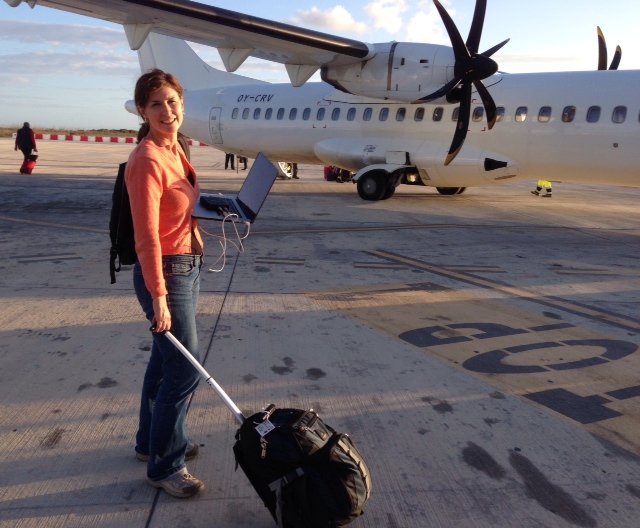
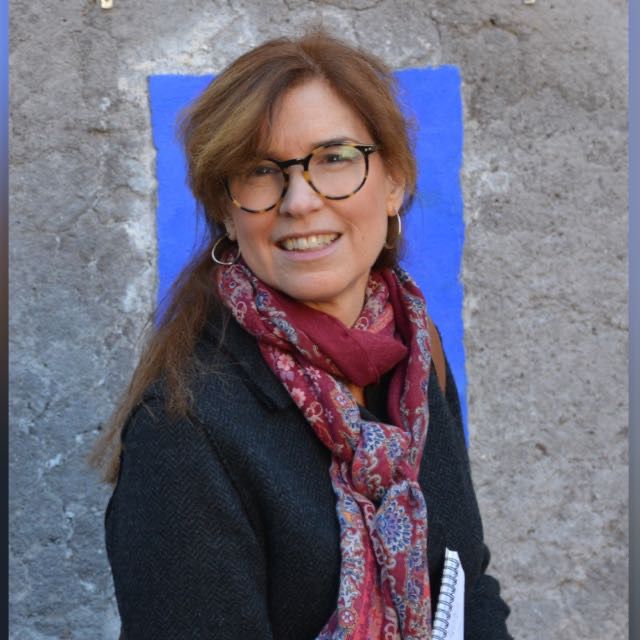
The situation is so sad and after reading what you wrote about how some migrants wanted to turn back after saw the boats and the risk, but the traffickers forced them on board, I realized these people have little hope any way you look at it. It’s just chance we were born where we were born and you realize it could be us on those boats, in those waters, if our birthplace had been different.
I totally agree with you Linda. Hearing these horrible stories of abuse and people who have no choice in life makes me realize just how lucky I am.
This whole story is tragedy from start to finish. These poor people just want a better life, but then they met up with the traffickers, and it seems that things go from bad to worse. Thanks for illuminating their plight. It is hard to believe this goes on. When the traffickers are apprehended what happens to them? Does Italy prosecute them or are they sent somewhere else?
Adri– you ask an excellent question which to be honest I am not fully prepared to answer. You are prompting me to become a better journalist. The traffickers are tried in Italy and I believe they are put in prison in Italy and not sent back to their countries. Apparently the traffickers are mostly Egyptians and Libyans and many of them are minors. I will look into this more carefully and get back to you though with a more specific answer.
Adri — I just spoke about this with an Italian journalist friend of mine, Luca Muzi, who has done many more stories on this question than I have and he said that almost all the traffickers are tried in Sicily and sentenced to prison there. The Judge can expel them when there are 2 years left to the sentence. They do not expel the minors.
A truly sad story to read and think about. Thanks are due to Italy for its past efforts. It is also hard to see that so many traffickers are minors. Thanks for your reporting.
Hi Joan, I also have a hard time imagining that the traffickers are minor but there are many teenage boys, especially Egyptians involved. I will need to do more research, but some have been arrested and are being held in Italy. Knowing teenage boys, I imagine they must be fearful and reckless and some are also capable of being cruel. As I said in my above response to Adri though, I am better informed on the migrants and less on the smugglers, so I will have to do some more reporting on that one.
. . good info Trisha. Were you aware that UK refused to contribute anything to rescue effort? When challenged that ‘it would lead to greater loss of lives’, Cameron responded that more dead illegal migrants would/might discourage more from coming – shades of that evil object Madeline Albright!
Hi Alan — I was aware that the UK refused to contribute to the rescue effort. I guess Cameron is playing to his conservative voters. I have to say I am impressed with Italy that has done so much especially when the economy is doing so badly. Mare Nostrum has been a very costly operation, but it was the right thing to do. The big question is what will happen now.
Trisha this is so painful to read. Do you know what happens to the refugees once they land and are ‘processed’?
I often wonder if these refugees are the same counterfeit handbag sellers I see on the streets of Rome and Naples with their bags spread out on sheets and who bundle them up and run like mad when the Carabinieri appear?
I would love it if you could talk to one of these handbag sellers and tell us all about it. I really feel for those people. I spoke to one in Venice and although he wasn’t North African, his story was heartbreaking. He was university educated and just wanted a better life in Europe but all he could do was sell these glow in the dark helicopters in St. Mark’s Square and hope for a few euros to support himself.
Thanks again for your great journalism, Trisha and your photos (I love the sleepy dog). We need to be kept informed about this issue as it slips away from our consciousness too often.
Kathy, I really should do a story on the African men selling the fake Louis Vuitton and Fendi bags on the streets. I know someone else who did a story on them. Interestingly in Rome, they are all from the same tribe apparently and they are also the migrants who are doing much better than others. Anyway, you’ve given me a good idea. I will do that story.
Very interesting. Very sad. Thank you for sharing this with all of us. Beautiful photography.. love that dog on the rocks too.
I liked the dog on the rocks too. A very mellow dog unaware of all the controversy and chaos surrounding his little island.
I loved that dog too. Just lying there in the sun ignorant of all the chaos and controversy surrounding his little island.
Thank you for your devotion to the Lampedusa saga. Painful as it is to read of things getting worse (!) for these immigrants, I cannot imagine how it must be for you to visit there, and to do so repeatedly. You are brave about letting your heart be broken, and I am grateful, for no one else brings this to my attention, not NPR, not PBS, not even the NYTimes. And, I cannot imagine how terrible life must be where these immigrantes come from, to make them still undertake this trip, under such adverse conditions, and when so much money, for them, is involved. The coyotes should be shot, really. And may the UN, for not demanding the world to open its doors to these needy people.
Thank you Nancy for your kind words. Yes, I often think about that too. How awful can their lives be that they would go into debt, spend everything they have just to get on what of these unseaworthy vessels and risk their lives. I really need to get working on a story on the traffickers, someone needs to shine a bright light on these individuals.
Excellent reporting on an increasingly common and tragic problem. Many cheers for Italy and their humane stance and action on this problem.
Had to laugh at the last picture of you walking out to your plane with your open computer in your hand ready to report on any unexpected incident. Keep up the great work.
L/D
Thank you Dad. The truth is I was holding Paolo’s computer because he was desperately attempting to recover a shot he had taken of some young Lampedusan boys playing soccer on a field right next to the boat graveyard at sunset. So the shot summed up our story well, the young people trying to have a normal life on Lampedusa, and this terrible tragedy all around them visualized in the boat graveyard. Unfortunately, Paolo formatted the P2 card — where our cameras record the video and we were not able to get it back.